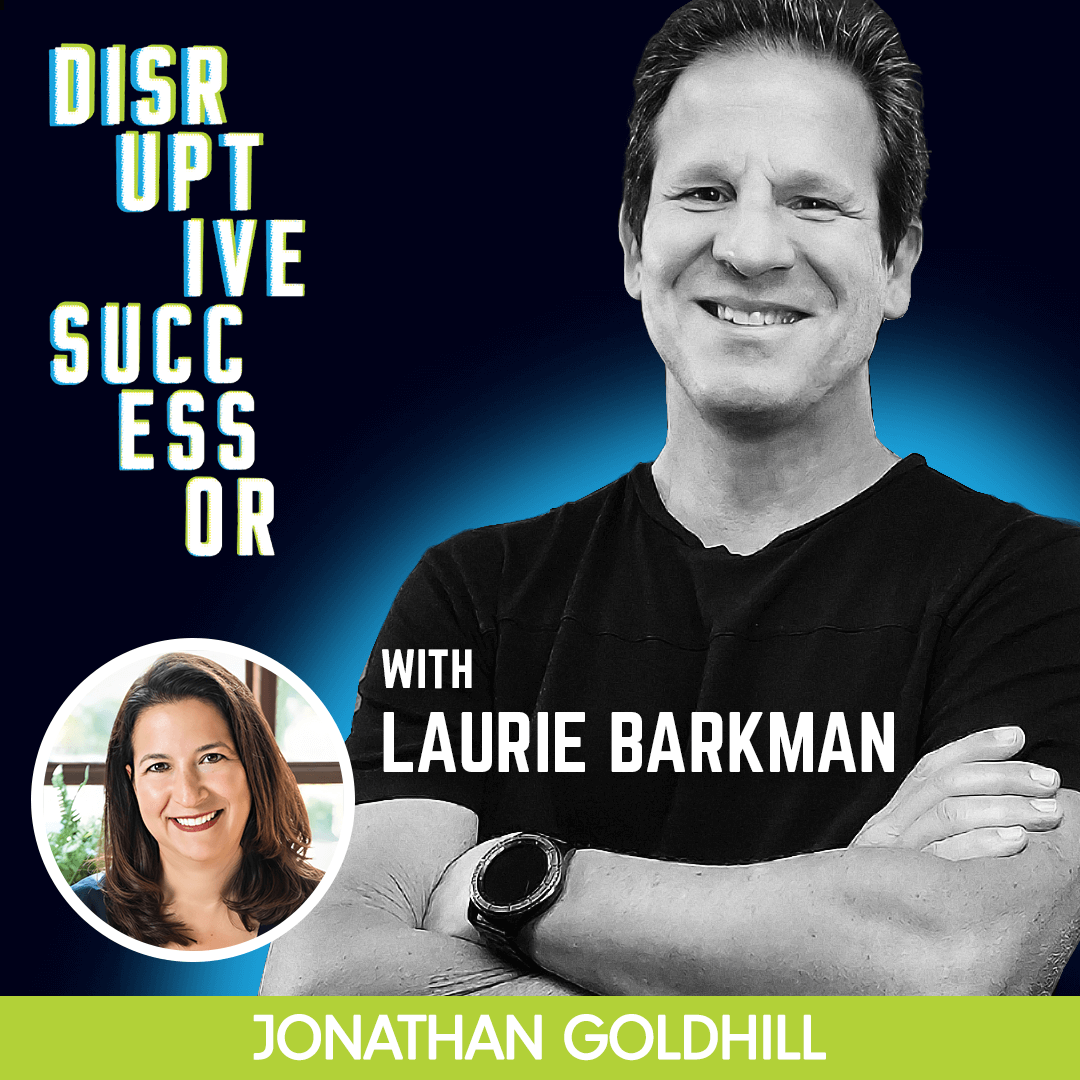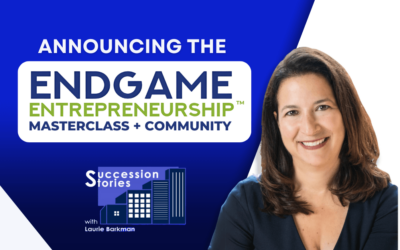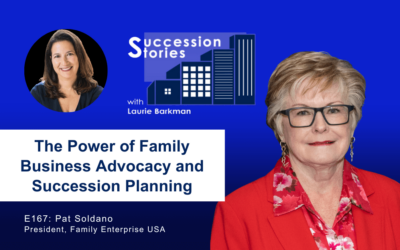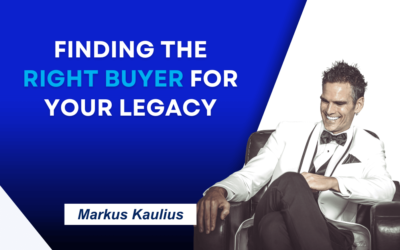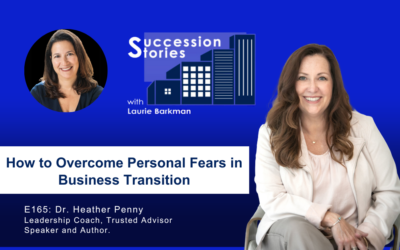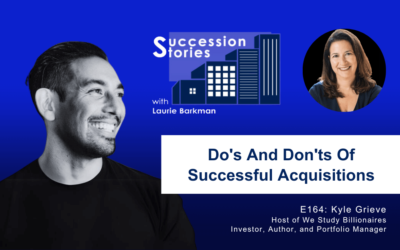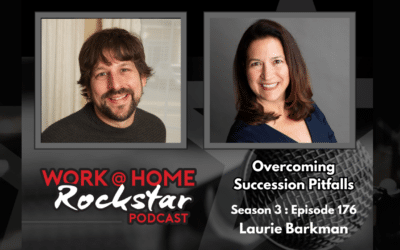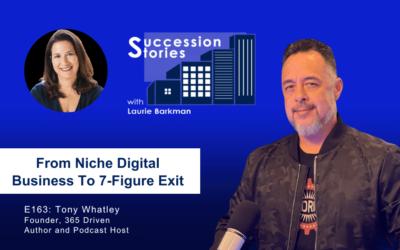In this episode of The Disruptive Successor show, Laurie Barkman, CEO, and Founder of SmallDotBig, joined Jonathan to discuss how to help business owners add value to their businesses and successions. Laurie shares her story and advice to business owners who are planning their exits and successions along the way.
HIGHLIGHTS
- Introducing Laurie Barkman
- Exits and successions are as important as building and running
- Laurie’s point of view on diversity
- Ins and outs of family boards
- Opening up to outside advisory boards
- Digging deep into strategic planning
- To sell or to transfer
QUOTES
Laurie – Surround yourself with equally skilled people to plan your exit:
“It’s important for them to realize that they’ll want to have the same kind of talent around them on the sell side or to the transaction side, whatever that exit is for them and their succession.”
Laurie – Diversity of thought, not the surface only:
“How I like to describe it, Jonathan is a diversity of thought, and people’s experiences and perspectives is what makes us diverse, I don’t really look at us on the surface and say, This is a diverse board.”
Laurie – Sell the business or transfer to the family:
“Selling versus the family is tricky for a lot of the reasons we mentioned, maybe we want junior to have it but Junior, again, doesn’t have the skills, either Junior is not interested, they don’t have the skills, or it’s a time sensitivity, where we just can’t wait that long to see what happens.”
Connect with Laurie and learn more about her work:
- About Laurie – LinkedIn
- SmallDotBig – LinkedIn
- Exit Value and Transition Advisory
- Jonathan Goldhill’s book, Disruptive Successor: www.DisruptiveSuccessor.com
View the Episode page on the Disruptive Successor Website
Transcript
Episode 90 – this is an auto-generated transcript and may have typos
[00:00:00] Welcome to Disruptive Successor, a show for next generation leaders in family, businesses and entrepreneurs who want to disrupt the status quo and take their existing business to a whole new level. We all know that what got us here, isn’t going to get us there. This show will provide inspiration, advice and resources to help you create massive impact.
[00:00:31] This podcast is sponsored by myself, Jonathan Goldhill and my company, the Goldhill group, where we provide coaching for growing companies. I’m Jonathan Golhill and my purpose is simple. To guide entrepreneurial leaders in family businesses towards more freedom and fulfillment. I want entrepreneurs to get clarity around the changes that will make them and their businesses more successful so they can experience the same freedom I’ve enjoyed in my life.
[00:01:00] Our proven practices, challenge, business owners to think differently. About their business and how they’re running it. And quite literally become game changers in our clients’ companies. Learn more at the gold hill group.com website, where you can schedule your free strategy session.
[00:01:25] Hi, it’s Jonathan Goldhill. And welcome back to another episode of the disruptive successor show. Today, we’re going to be talking about transitions, succession and exit planning. My guest today is Laurie Barkman who calls herself a business transition Sher. Her firm, small dot big advises owners on having more valuable sellable businesses.
[00:01:49] And as a partner with Stony Hill Advisors, a mergers and acquisitions firm, she guides them through the complex process of letting it go. Lori is the former CEO of a hundred million revenue company with exit to a fortune 50 company. With more than 25 years of C-suite and award-winning marketing expertise.
[00:02:12] She provides actionable perspectives to drive sustainable value. Lori, welcome to the show today. Thanks, Jonathan. It’s great to be with you today. Awesome. So, uh, Hey, why don’t we just get started be, you know, we’re gonna be talking about transition, succession planning, how to prepare yourself for business transition, how to value your company.
[00:02:35] Um, maybe some of the mistakes when valuing, maybe some of them mistakes when selling your company, but like, People always, probably start with like, why should I listen to you? And so you know, people who are, are critical, uh, or suspect, especially business owners who are thinking like you’re gonna sell my business.
[00:02:55] I mean, I know my business better than anyone knows my business. Like, you know, what have you done? What have you known? So like, Tell us a little bit more because you could brag a little bit more than what I did. I mean, that’s a pretty impressive exit I would certainly say, and that’s a pretty impressive company, but like, what’s your educational background?
[00:03:14] You know, how did you get to do what you’re doing? And you know, how did you get here? Oh, sure. Happy to share some of that with you. I got my start in business and I like to call it the psychology of business. My undergraduate degree is from Cornell university and I, my degree is industrial labor relations and I went into human resource management.
[00:03:32] So I call that the psychology of business when you’re working with people and teams to help make things better. Uh, and be more productive and happy and ultimately be profitable. But ultimately then I switched gears and went to Carnegie Mellon university, got my MBA at the Tepper school of business. And I focused a lot on marketing and technology and entrepreneurship.
[00:03:56] And I got my start working in startups after I graduated with my MBA. And I think what’s really interesting and unique about my background is that I went from. Big co I was within Ersel Rand company at right outta school, in HR to startups back and forth. So throughout my career, I have had the fortune of working with small, nimble agile companies and understanding what that looks like and feels like from an entrepreneurial perspective, to going to large global C.
[00:04:29] Environments where you have more resources, more well-established processes, and I’ve brought some of those learnings back and forth. And then ultimately after a career long career in marketing, focusing on the digital space and all things, process improvement related to that. But. Top line growth as a primary focus, but eventually found my way into a CEO role.
[00:04:52] As you mentioned in my bio mm-hmm and I was an outside hire for a third generation company, and the vision was to have a, a bench, right. There was a long term succession plan because for this particular family, the, the two sons were not interested in being part of the operations for the business. And they needed to have a pretty deep and wide bench for running the company.
[00:05:16] And they already was a nice bench before I got there, but they wanted someone like me who had more entrepreneurial experience because a third generation company. And at that time it was about, I don’t know, what’s called 110 years old. Sometimes you get further and further away from the entrepreneurial spirit you get.
[00:05:35] So. Uh, it’s important to be structured and it’s important to have that structure and that’s important for growth and stability, but also. There can be a nimbleness and a, and, and an eye towards technology and process improvement to bring in from the outside. So that’s what I had brought into that experience, going through the M and a process from the inside was also hugely important.
[00:05:58] The playbook of the global company that bought us, of course, you don’t run into that all the time, but seeing how they did things and under experiencing what we did as a management team, to. Uh, to go through the sale, you know, it was a complicated process, but we also had to run our business day to day.
[00:06:14] So I can empathize with business owners, for sure on that point. And a lot of times for business owners, this is the only time they’ll ever do a transaction. And they’re really good at running their company and building their company. And just like when they have to surround themselves with. Talent to help them do that.
[00:06:32] It’s important for them to realize that they’ll wanna have the same kind of talent around them on the sell side or to the, to the, the transaction side, whatever that exit is for them and their succession. So that’s really how I, I transitioned eventually. I, I, when I, after I left, um, After the, the merger and acquisition phase, I was there a year and a half as an officer of the new company and, uh, the acquiring company.
[00:06:57] And then I went into private equity. And so I kind of got more involved on the deal side. And I guess if I admit it, I’m a little bit of a deal junkie. I like the pace. I like the. The the a to Z nature of having something and seeing it through. And the marketing side comes out really well in mergers and acquisitions, because we need to package and sell the, the benefits and the, the, the opportunity for this company.
[00:07:23] But then there’s all the other things that blend into it. And so having a, being a CEO, former CEO, and, um, being in startups, being in large companies, all these pieces that put together, I really can take the process. To, to different companies. So my job now is I’ve got a process and I can bring that process to the business as opposed to them, trying to figure out the process on their own.
[00:07:47] And that’s a really important thing. And so I gather up all my experiences, all my certifications, not only my MBA. But I’m a certified mergers and acquisitions advisor. I have a certificate in exit planning and I also have a certification from the value builder system, which is a system. I know you’re familiar with Jonathan.
[00:08:06] Yes. It’s all about a, a system and a methodology for, for working with business owners to help them maximize the value of their business and help them see things that they’re not seeing. And, uh, so that’s the long and the short of it. Yeah. You have an impressive resume. I have to say. And kudos to you. Uh, um, being a woman as a CEO in a, in a third generation family business, I think is, um, I mean, being a man or a woman in that role, but you know, it’s great to see more women CEOs.
[00:08:38] I have to just say, um, what was it like to be brought in to a. Third generation family business and be an outsider. How help? Well, I was brought in to run. I was brought in to run a division mm-hmm and so there already was a culture of outside leadership. Okay. In the business. I was certainly not the first outside hire mm-hmm and I was part of.
[00:09:02] A retirement for the business unit. So the prior the incumbent was, was retiring and that was his intention. Mm-hmm . And so that helped pave the way, because it wasn’t a shock to the system. There was a really, this is what I would say for anyone considering succession is to be at the right time, you know, communicating what the plan is mm-hmm
[00:09:23] And that, that way, when there was a recruiting process, whether it was my peers or whether it was, um, People who other stakeholders in, in the company who were involved or board members I interviewed with, uh, good 360, you know, team of, of folks from, again, whether it was my peers, people who reported to me and people above me, including my boss, of course, and then, and then board members.
[00:09:47] And that was very comprehensive interview process. So what did that feel like? Yeah, it was daunting for sure. Um, It took about six months to get through all the pieces of the, of the process. They even had an executive coach working with them. I did all kinds of assessments, the D I S C and the, I can’t remember the alphabet suit, but there were two or three different, uh, personality assessments that I needed to take.
[00:10:11] They really. We’re doing a, a very thorough job on the fit. So by the time I got there, there was a great anticipation of, oh, who is this person? And, you know, and what we could, what we could accomplish together. Um, but yeah, no, it’s not an easy thing when there’s a very well established community, especially, you know, you acknowledge that I was.
[00:10:32] Yeah. I was, uh, the only woman in the room for a period of time. wow. Over time that changed. But I was the only woman in the room for a while. And, but I had been used to that. I had been in manufacturing. Yeah. I had been in technology. Yeah. So I never really, that never really, uh, was weighed on me socially.
[00:10:50] I was always, I’ll go to the bar, I’ll play golf, you know, whatever. Mm. It never held me back. But it certainly was good to get more, uh, diversity in the room over time. I think it’s great. And I think it’s important and you know, in some states and you can speak to this probably better than I, but they’re legislating more women in the boardroom and then, you know, as officers and I, I’m not so keen on the idea of legislating it, um, I’d rather, it just happen because of an enlightened self-interest a, a, a greater.
[00:11:23] Whatever a heightened state of consciousness is awareness that we need balance. We need diversity in, um, but I’m not big on sort of affirmative action type programs. It feels, um, uh, well, we’re not gonna go down that road. It’s a little reaction. Yeah, no, what I like to, how I like to describe it, Jonathan is a diversity of thought and people’s experiences.
[00:11:44] And perspectives is what makes us diverse. I don’t really look at us on the surface and say, this is a diverse board. You can have correct people of different genders and, um, Ethnicities, but they all think exactly the same way. I think we benefit our stakeholders, our shareholders benefit when we challenge ourselves appropriately because we’re bringing different things to the table.
[00:12:07] And that’s what I like to do with my clients. And that’s what I like to do in general. I’m a board advisor for a privately held company, a second generation construction firm, and they created a new board of advisors. We launched. As a board of advisors last October. So at this time of recording, it’s, it’s coming up on a year almost.
[00:12:25] Mm-hmm . And it’s a startup board. So you have, you know, that, that dynamic, but I, I appreciate that this second generation was trying to do something different. They knew they needed some outside guidance. And when they went through the interview, I went through the interview process. Uh, they chose three of us and they did, they looked at our skill.
[00:12:46] They looked at what we brought to the table and I can say it’s definitely been an advantage to have us, um, coming. Things from a different perspective because ultimately it’ll help them make better decisions. Yeah. Well that sounds like a really interesting subject. I’d like to dive into more. I don’t know how much you can share, but can you tell us a little bit about the size of the company, maybe, uh, either revenues or employees?
[00:13:13] Um, a little bit. The current leader, are they, uh, a next generation leader and, and, you know, like what was the level of the sophistication in the company that they decided to bring informant an outside advisory board and I’m wanna make this instructive to people that are listening and thinking like, should I be putting an outside advisory board?
[00:13:35] Am, am I too small? Am I too young? Am I too inexperienced? Or will they take over the direction? You know? So talk to us a little bit. How that came together with this company? Yeah, absolutely. Let’s let’s, let’s put it under the umbrella of governance and there’s two types of boards that we’ll focus on, I think to your question.
[00:13:58] Sure. There’s a third type, which, uh, this particular company doesn’t have at the moment, but oh, I guess maybe they do, if you think of it that way. All right. Let’s talk about all three. So one is a family board. Now this, this, in this example, um, it’s a construction company and there are three brothers mm-hmm , there was a, a sister in the business, but they recently bought her out.
[00:14:22] Mm-hmm the four siblings with their voting and, and each company could be a little bit different. How the voting, uh, shares are, are spread across the siblings and or parents and or grandparents. Right? The, the generations involved in the business. So sometimes in a family board, That’s a separate type of entity.
[00:14:42] Right. And they talk about different things than they might in a. Fiduciary board. Right? So a, a board of directors has fiduciary responsibility. It’s, it’s obviously most common for publicly traded entities, but it, you can also see this in private companies where a private company may have, um, equity or shares that are, that are offered to board members.
[00:15:09] And then the third type, which is the type I’m describing for my current experience is as an advisory board member. So we are not financially, um, accountable for the business, the way a fiduciary board would be. Sure. Um, but we of course wanna provide good guidance. Um, the other difference between an advisory board and the fiduciary board board of directors is that.
[00:15:33] Um, the board of directors, their primary responsibility is hiring and firing of the CEO or the, the leadership of the company. Mm-hmm for the board of advisors. They are not responsible for that. Sure. We make recommendations. The, the management. Can choose to listen to us or not. You know, we’re we’re of course they, they they’re, we’re there for a reason, but ultimately it’s their choice.
[00:15:59] It’s not about voting, you know, they there’s, no, we don’t have a vote to say they need to do it. We’re we’re suggesting we’re purely advisory and then they can decide. Do you think that the content of what you’re talking about in the advisory board room versus the board room of the fiduciary, uh, board of directors, do you think the conversations are fairly similar?
[00:16:23] I, I mean, in terms of the content, like where you’re both talking strategy, you’re both talking about, um, how to drive value in the business. You’re talking about the CEO role and maybe even some of the C-suite or director level positions. Do you think the content’s the same? I do. And I don’t, I think again, let’s take a public company board, for example.
[00:16:45] Um, they will have regulatory requirements, um, and financial review and all kinds of other things. Sarbanes, Oxley, I mean, all kinds of. Sure governance, right. That may dominate their head space and their time from a financial review and responsibility, et cetera, et cetera. Now, in a private company, we, as an advisory board, um, we do have access to their financials.
[00:17:16] You know, they share that with us. Mm-hmm we do have, uh, and we do discuss that and we also discuss. The strategic plan, we discuss all kinds of things that, that to your point, yes, those topics would overlap with a, a board of directors type of role. I think the difference is there’s probably a whole other level of financial review and sign off and of course, ethics committees and all those things that some boards, but a lot of that doesn’t really.
[00:17:47] Too well in family businesses, I don’t think so. That’s so, and I wanna focus on the family business. Like there’s. Um, you know, they’re just, they’re very unique and different from, I mean, many public companies are still family own and control. Oh, absolutely. Yeah, absolutely. But for you’re right for the private companies, um, where they don’t have to go through that extra level of scrutiny, but they may have, you know, audited financial statements and they should have mm-hmm
[00:18:15] Now you asked a question earlier about the size and should I be considering. I have a podcast called succession stories. Mm-hmm and you’re gonna be a guest on my show. You’re coming up in a couple weeks. And one of the guests that I had in the past works for a, uh, private placement company where he helps place CEOs and place.
[00:18:35] Board members. And we had a great conversation about this and I asked him straight up, just like you’re suggesting, is there, you know, when should I be thinking about this? And here’s kind of a rule of thumb and, and certainly you’ll find exceptions. If the company is, let’s say under 20 million mm-hmm that you might see an advisory board.
[00:18:54] If it’s around 40 million, you might start to see a board of directors, right. A family board can be at any time. Do you think it is typically when there’s multiple generations or just multiple family members? It could be either. And there also could be, excuse me, the history of having that family board in place, having that history in place.
[00:19:22] Is important when there’s multi-generational, um, entity. So one conversation I had with the CEO was really interesting. He’s the fourth generation CEO of highlights magazine and his name’s Ken, Ken Johnson. He is, he’s talked about this story elsewhere, but we talked about it on my show. Mm-hmm and, and what he had said.
[00:19:47] He did not wanna be part of the family business. He didn’t, he, he got his, uh, PhD in physics and was working in, in science and, and laboratories. And eventually what got him into the family business and eventually got him into the role was they had what, an established family board. And it was part of their.
[00:20:11] I’ll call it a tradition, but I think it’s best practice where they had a way of bringing in other young family members as like a junior member of the board in some companies it’s age based. I have another, um, guest of my show talked about her family and it was at age 16. That they introduce and they have a ceremony and it’s an important thing to introduce the young person into the family board and what that means.
[00:20:41] Now that particular show with Shelly Taylor. Um, there’s a lot of people involved and it’s once a year family meeting, they come in from all over the country or maybe they’re zooming in, you know, electronically, but, but nonetheless, um, and back to Kent for a. Because he became part of this family board. He started to understand some of the issues he UN wanted.
[00:21:07] He understood more of the vision and what was important to the company. And then they also had some leadership tragedies. They had some outside, uh, hires that were part of the leadership who passed away. There were some tragedies and, and some illnesses and he realized how, how he was needed. And how he could make a difference and he chose his path and, and joined in as CEO.
[00:21:28] So his way was via the board first mm-hmm and then to the management seat. Um, so for some other families, it’s, like I said, you know, that 16 year old and then gets part participating. And for others, it’s, uh, starting on the shop floor and getting experience and then maybe leaving and going, working somewhere else and then coming back.
[00:21:46] But however, a family does it is, is, you know, can be unique to them. But one of that, that common theme is. Um, creating a, uh, I’ll use the word tradition, but creating a process or creating a, a structure. So it could start with, yeah, it’s the two brothers, right. Or it could start with mm-hmm the two brothers and the spouses and the mom and the dad or whatever your formula is.
[00:22:09] That’s okay. Mm-hmm um, but a consistency. I think the, going back to the advisory board that I’ve joined for this construction company, they had a family, um, I guess I’d call it the, the family board and they would meet maybe once a year, but it was very unstructured. And so they realized they needed more structure and that’s why they chose to, to formalize an outside advisory board.
[00:22:35] It’s great. It’s interesting. And, uh, I think boards are really valuable. Let’s move away from this topic, but I wanna just emphasize that the importance of boards is almost similar to the importance of being in like a CEO peer group. Um, The outside perspectives of other people inform you in maybe the way they’re doing business or the way you could be doing business.
[00:23:03] And it’s really helps to open. Your ideas around what are what’s possible. And, um, and also like what’s not working and should be working better and you know, could be addressed. And so I’m a big fan of obviously coaching peer groups, board of advisors I’ve been involved in, in all of the above and including boards of directors.
[00:23:27] So let’s talk about, you know, in your capacity as a Sherpa, Transitioning companies, um, looking. Valuations of companies is probably one of your starting points I imagine. And then the end point, which is usually what your client is looking for, um, is your goal. And your work is to get from the starting point to the end point.
[00:23:53] So maybe you have some stories or a story around a starting point and an, and an end point. Um, but let’s talk about. What the process of valuing a company so that you can increase its value over time. What are the, and what are the, some of the value drivers? So I know it’s a complex question we can kind of go back and forth on.
[00:24:17] Yeah, well, they’ll do it. Yeah. And by the way, just to back up a, a hair on, on the word, Sherpa, that insinuates that I have a process, there’s a roadmap as you’re asking about. But also look, I, I wanna also acknowledge, I don’t have all the answers. We gotta work collaboratively. Sure. I heard Jonathan, you were on another show and you talked about the boat, right?
[00:24:36] The business owner advisory team. Mm-hmm so this is definitely. Uh, a good role to have on the team. And if I’m that person, then that’s quite an honor to be, to be that person. Um, and yeah, starting with business valuations is really important cuz it’s, it kind of just begs the question. If, if owners are thinking eventually about a transition and by the way they all should, because it, the sad truth is, and the honest truth is all business owners are gonna leave their company one day mm-hmm
[00:25:04] Everyone will, right? Why not try to control that process and have some influence on that process. So in the valuation process, what we do is we start with, where, what are we, what are we working with? You know, people say, well, what’s my business worth. I have no idea. Okay. Right. So what we of course are going to do is look at your financials, right?
[00:25:25] We’re gonna look at most. Typically the past three years might be occasion that we’d look at four, four years or five years. Everyone asks about COVID. What impact might that have on my evaluation? I, what I’m seeing is that the questions are more around, well, how have you come back? What does 2022 look like?
[00:25:44] What did 21 look like? We’ve we’ve got a little bit more behind us now. It can be an exception year. If that was the downturn after you had a strong 19 and then 20 took a dip and now 20 ones back up, some companies don’t look like that though. Maybe they, they have stayed relatively flat. Maybe they’ve continued to decline.
[00:26:04] So buyers are looking for trends and is that trend upwards, downwards flat somewhere in between. And if we can explain some of those things, then that’s helpful. I have seen owners take their foot off the gas pedal. You talk about risks. Yes. Ultimately what we are looking for too is having a business that’s transferable mm-hmm because a business that isn’t transferable really has less, has less value.
[00:26:31] And why is that? Because transferability translates to risk. If an owner is the. Is the, you know, in our, in our advisory capacity, sometimes we talk about this, this term called the hub and spoke right where the owner is the center of everything. They’re the key firefighter. They are the key salesperson.
[00:26:51] They know everybody’s, you know, birthdays and the customers by first name. And that’s lovely and wonderful. And it’s probably has helped them through their early years, but that’s not really a transferable business when we remove the owner and the business takes a nose dive. Likewise. If during this period of time, uh, that we’re talking about, which is a three to four year period of time.
[00:27:12] If our numbers are flat, then we might wonder has this, you know, business plateaued ha or, and, and they might not realize if the owners actions are going to be harming the value of the company. Maybe they just took their foot off the gas pedal mm-hmm because they’re tired. But it all fits together, right?
[00:27:36] These puzzle pieces fit together and that end creates the risk. What is, so if, if it’s all about the owner and they’re the ones driving the process, Then what will be the growth opportunity for the new owner? So other value drivers include what industry you’re in and ultimately what size the business is because there is a discount applied to smaller companies, again, because of this perception of risk.
[00:28:01] Sure. We worked out the kinks and the process. The team, the management team, are they surrounded by great people. And if a new owner comes in, can things continue forward or they have to hit a reset button and the risk associated with all of that. Is there customer concentration, is there revenue concentration?
[00:28:19] So if we have more than 20% with one particular customer, we’re not contracted for that revenue and it disappears, boom, we’ve lost, you know, a, a good percent of our profit. That’s a. So we look at different dimensions around the industry. That’s served too different industries do have different growth, potential, different growth rates, and also different business models.
[00:28:44] The types of companies that have a business model that has recurring revenue associated has more predictability of future cash flow. Those businesses also could see a greater valuation. There’s a lot of intangibles that can also play into the valuation. When we do valuations for clients, we like to describe it as an art and a science there’s different methodologies for using valuations.
[00:29:10] How we do it, we have. I’ll that’ll I won’t go into detail on the different, um, financial tools, uh, to, to bore people with a finance class here, but at a high level, it’s about, um, the history, what expenses we might wanna look at in saying for future owner, they might wanna make different decisions and we normalize, we normalize things.
[00:29:33] So we can maybe say in this expense, Would be an add back. We would add that that back because a different owner might make a different decision. We have to explain all those things. Sure. That’s step one is getting organized. And then step two is looking at all these other nuances of growth, potential the management team.
[00:29:53] The risks associated in the business, the processes, I know Jonathan with traction and EOS companies that are more, um, well organized. They have their processes documented. They have a strategic plan. They’re following it. They have level 10 meetings. All of those things go into making that company work well and be able to thrive without the owner.
[00:30:14] Um, other intangibles could be the brand, the brand reputation. It could be. It could be the value of the, of the customer database, the niche that they’re in, the differentiation they have. What’s the special sauce. What really makes this business different, unique? What will make it valuable in the eyes of the buyer?
[00:30:33] It’s not that different from, from a house. Sure. Why would, why would someone who’s looking at houses on the same street, pay more for that house versus your house? Do you have the finished basement? Do you have that? Uh, you know, all the, uh, the Viking appliances that are hard to get these days, it takes three years.
[00:30:54] You know, all those things, houses are a lot easier to value for the most part than, uh, I mean, unless they’re, uh, Really unique homes and, or in unique, uh, communities, um, such as the one that I’m living in right now, um, very large unique homes and unique communities, but really, uh, when we’re talking about a business, so many businesses are so different.
[00:31:18] Do you find that your clients want a formal valuations as a starting point? Or are they okay with. Something more like a back of the envelope type of valuation. Where, what, what is there, and does it depend upon the size of the company? What, as far as the level, uh, the degree of certainty in terms of valuing, I mean, ultimately a business is worth whatever someone will pay for it.
[00:31:48] And, and I’m, I imagine you’re surprised often or often enough as to what something. In the value in the eyes of a buyer might be worth, it might be worth a lot more or a lot less. Yeah. And that’s right. And that’s, that’s how we caveat the exercise of doing evaluation is this is a range of value. Mm-hmm we create a range of values using different valuation methodologies.
[00:32:13] Sure. Based on the tax returns and current year information that’s been provided to us. And as I mentioned, we’re making. Certain adjustments in conversation with the owners. And then we’re looking at the market factors and we’re looking at other, uh, intangible factors of the business to make this determination.
[00:32:32] We also look at comps. And to your question about comparatives, is it. Good to just do a back of the envelope and kind of get a rough estimate. Well, I offered that and I know, you know, you’re familiar with this too, with the value builder system for anyone listening. If they’re interested in getting a value builder assessment, um, happy to do that with them.
[00:32:53] And one of the things that we can do is a back of the envelope. The value builder assessment takes a looks at, takes a look at strengths and opportunities and risks in your business and bumps up against a kind of a, a formula. Based on, you know, some of the adjustments I mentioned, et cetera, and, and net income or EBITDA, um, estimates for the past three years.
[00:33:16] Yeah. That’s an out of the box number now. I also, because I do valuations, I like to compare. What I see for comps, I have the detail, right? I like to use last within the last five years. I like to understand what those comps are. Are they roughly in the same size business that I’m looking at? I have more of the detail at my fingertips and that’s helpful.
[00:33:41] And that way, um, we are presenting, I think, a, a larger, a larger look at this to be. To be, um, to be more objective about it. Mm-hmm and again, it is a range of value. What’s nice to have as a starting point is to say, um, a little more definitively, we’re never really gonna be a hundred percent sure because we won’t know until it sells what the market will bear for.
[00:34:07] It. It does help us at the outset also when I’m working with a client and I wanna understand what their financial objectives are to know if we have a. And I am finding that right now. I do have some clients that their vision is to sell their company for, uh, making up these numbers just for conversation.
[00:34:24] Well, let’s say they wanna sell it for 6 million and they’re currently valued at two or one. And some of these folks are in their late fifties and there’s not a whole lot of runway. To you know, five X the company, and that is a challenge. And so if there’s one key message for the audience, and if they’re wondering, why would I get evaluation now?
[00:34:47] I’ve, I’m not anywhere near selling my company. It’s not on my mind at all. Great. This is a perfect time to get evaluation. We should. I agree. Baseline. Yep. Where are you today? And if they also don’t know what their goal is, that’s probably. Good thing to talk about. I know you probably talk about with them.
[00:35:06] Jonathan is not only where are they today, but where do they want to be? And then what I like to talk about, you know, in the sheer role is let’s reverse engineer that. So you asked about stories. I mean, I could talk about a couple of stories, but that’s the process in a nutshell is where are you today?
[00:35:22] Let’s do a Lin. Let’s understand where you want to be and let’s understand the gap. And that gap can be pretty wide. If the gap is not wide. Awesome. Let’s talk about options, but if it’s wide, what are we gonna do about it? Yeah, I think, uh, you know, I’m sure you talk on a strategic level with your clients about planning for growth.
[00:35:45] I think too many companies. They don’t think that strategically, um, the smaller companies I’m talking about, they are, and I’m not talking about the hyper growth companies. I’m talking about your garden, variety, construction, uh, two to 10 20 million company that doesn’t see. Any points of strategic differentiation and oftentimes their marketing doesn’t reflect that much strategic differentiation.
[00:36:17] And so, uh, do you find. Part of the exit planning and, and, uh, and valuing of the company helps to drive them into more strategic thinking or strategic planning activities. Yeah, absolutely. It does. Yeah. And I’ve created a, a process that I call strategic exit value planning. Mm-hmm it takes the methodology of strategic planning and it layers in.
[00:36:43] The steps of the process that can take a, a good six months to go through because we need to get our arms around not only wh what are the risk factors and the strengths mm-hmm of the, of the business today, valuing it as a step, as we talked about understanding your financial goals as the business owner.
[00:37:04] And then, Hey, by the way, we should also talk about your personal goals, because it is. Emotional too. And we wanna recognize that. And so we look at it as this three legged stool. So the process, uh, also moves us into the, what are we gonna do about it? You know, what do we need to prioritize and how can we, how can we map this out?
[00:37:25] And. Then we’re the starting line. Woo . You know, we did all this work. Yeah. And in some ways that gets us to the starting line, but isn’t that important to know? Isn’t it important to know what could be holding you back if, uh, if you’re setting a course that. There’s this one, uh, gentleman who was on my show and he had established a really great company and they were doing well.
[00:37:48] Um, but he took it on his own David Wes’ name. And David had a, a company called industry weapon industry weapon had a business where they were doing, um, digital displays and they were doing again, they were doing well, but he knew inherently. That he might have been missing something and he took it upon himself.
[00:38:11] We weren’t working together, but I loved his story because I loved telling people, this is what I helped them do. He, over the period of like six, six years, he had conversations with different potential strategic buyers, different private equity groups. And he was just learning all the way he was learning.
[00:38:30] What was he learning? He was asking good questions about some of the, the deals that they’ve done. What do they look for? Size of deal different criteria. What are elements of the business that are important to them? And in that process, he learned. That project revenue was less interesting and recurring revenue was more interesting.
[00:38:49] Sure. And they had a strategic pivot. They, they needed to really change the business model made to change the products and what they offered. And it paid off. Eventually. I think he had shared, I think his rev recurring revenue wasn’t a hundred percent, but it got to, you know, went from zero to like 40%, which was no small feat.
[00:39:07] Well, that’s, that’s great. Yeah. And it became a, a success story in the exit. And I love that episode. If anyone’s gonna go search for it. It’s, uh, I think very telling about this example of reverse engineering. He, he did that and it paid off for him and he had the luxury of time. It took him, it took him about 10 years, I would say.
[00:39:29] So let’s talk a little bit more about how to prepare yourself and your business for transition. And there’s really, I think two types of transitions or, well, at least there’s at least two, maybe, but one is, is selling exiting. Um, one that we’re not gonna talk about is just shutting the doors. Um, but the other one that I want to talk about is that, you know, is transferring to a, a family member, a next generation family member, and.
[00:39:58] Do you see a great distinction between the, the first where you’re gonna exit to sell. And, and then the, the other one where you’re going to just transfer and transfer some of the equity, but maybe sell it to your kids or transfer it to your kids. Well again, if we start at the beginning, which is what’s important to you, what are your goals?
[00:40:20] What’s important to your family? If especially also in context, am I talking to a founder? Am I talking to a next gen leader? Second, third, fourth, fifth on my show. By the way, I’ve interviewed generation nine and 10. Wow. Imagine the, the. Difference between talking to gen 10 versus gen one, right? Yes. You can probably just assume a level of emotional difference between those two people.
[00:40:46] So let’s assume it’s the founder. Now the founder on what he or she is thinking could be maybe they founded the company with that bill to sell in mind. Right? For the book for John, from John Warlow, maybe they’ve always intended to sell it. And so helping them get there is going to be it probably quote unquote easier conversation than someone who’s thinking.
[00:41:10] Well, my brother and sister are in the business now and my son might be in the business. And I’m thinking about. The next gen and my family. So we have to talk through all of those things. And I think the main thing is what are the options? Why, what are the pros and cons of each of those exit options? And there might be other what I call exit channels to consider based on what your goals are.
[00:41:35] So if your goals are more around legacy, Sustainability for the future back to highlights magazine gen four. Sure, absolutely. He envisions that this company is not necessarily it’s about him, but it’s about the future and he’s all about making sure this company is sustainable. Um, and, and maintaining their legacy.
[00:41:57] Now, whether or not they stay a family held company. I don’t know. Um, the culture and the mission for them is very, very clear for others. They. Are more open and they might say, well, I don’t, I don’t really know. I kind of wanna lay out what are all my options are and I wanna explore them. So for example, yeah, I might sell to a third party.
[00:42:17] That third party might be my management team. So, uh, it’s in, it’s not related, but it’s related, right? It’s not blood, but it’s related. These are insiders. They know the business really well. Um, sometimes a sale might be contemplated more so as a skip generation. Well, we wanna have this generation in. We wanna, you know, they’re, they’re 10 years old right now.
[00:42:40] We wanna give them another 10 years. We wanna put mentors in, above them, rise them up and see what happens. All those things need to be on the table. Because again, if we have time on our side and we have the luxury of creating a roadmap, maybe some of those options don’t pan out. What if junior. Doesn’t have the skillset doesn’t have the wherewithal to want and they, they don’t even want the business.
[00:43:02] I’m seeing that more and more. It’s very common junior just, just does not want the business. And a lot of times senior is disappointed. They thought junior would want it, but then Junior’s in the business and junior realizes they don’t want it. So it could again be this, Hey, option one. We wanna, we wanna.
[00:43:24] Uh, we wanna create a succession plan, an ownership plan with junior, but now we gotta go to plan B. We wanna sell the company because to a third party, because we, we’re not finding that this family next gen situation’s gonna work out another option that’s worth looking at. If the goals are around maintaining a sense of community, maintaining a sense of, um, Uh, that we want, the company employees to benefit is an ESOP.
[00:43:54] An ESOP is a, is an option for larger companies. It’s not an option for a lot of small companies. I think generally speaking about two to two and a half million of EBITDA a year. Is it roughly the size of a company that might, might take a look at something like this? It’s very common in construction.
[00:44:12] It’s common in professional services, like engineering services. Mm-hmm accounting firms. Um, I see it here locally. We have a window manufacturer, so it could be an industrial type of company too, where the family maintains. And ownership stake. They might sell a piece of it and they’re selling it essentially, um, to, uh, it, employees are benefiting from the, from the growth of, and performance of the business.
[00:44:41] That is less known. Um, putting it out there just again as another option. Sure. Most of us are familiar with selling to a third party and they kind of conceptually understand that and ESOP feels a little more foreign and, and a little more daunting. And I get that. Uh, so if it, people are interested in learning more about that, I’m happy to be a resource.
[00:45:00] I, myself am not an expert, but I have, we have had guests on the show who a ESOP expert. Exactly. We wanna point them in the right direction to direct them to. And that’s, and I’m happy to do that too, but, um, yeah, and I think, you know, selling versus the family is it is tricky for a lot of the reasons we mentioned.
[00:45:20] Maybe we want junior to have it, but junior again, you know, doesn’t have the skills either. Junior’s not interested. They don’t have the skills or it’s a time sensitivity where we just can’t wait that long to see what happens. There are a lot of things that happen that are hard to explain, you know, when we come in as outside.
[00:45:42] Experts, so to speak, uh, advising them with our processes. I think sometimes we’re surprised by what, uh, the ultimate outcome is. Um, I was approached recently by, uh, a guest on my show who was offered, uh, to sell his business at a multiple of about 15 X, which for a small company. Six location, uh, facility business.
[00:46:12] Um, that was probably an astounding amount of money. 40 multiple of, of, of EBITDA. Yes, that is a pretty high, multiple, what industry was it in? I I’d rather not say cuz he was a, a guest on the show and so gotcha. That quiet, but he wasn’t really sure what he was going to do, uh, because he didn’t know what he would do if he sold the business until he was leaning towards not selling it.
[00:46:38] And I said, You should never live, look a gift for symptom health like that. It’s not often that you’d get an offer like that. There’s a lot of consolidation going on in your industry. You need to think long, hard, and twice about this. Cuz. If you want, you could go out and do it all over again. And if you’re really that passionate about the industry, um, or you could be an advisor, you could set up a family fund, you know, uh, you could be philanthropic, you could move you, could you, I mean, it’s a game changer when you’re making that kind of money and yet not everyone is ready for, uh, For that transition and not everyone knows what the outcome is gonna be.
[00:47:22] And so that was my, my point in this earlier part, we come in as advisors and to us, it looks clear. It looks black and white, but it’s not. I mean, uh, it, it could be very, a very different color than what we thought of. Yeah, absolutely. And there is a sense of remorse when no a great offer goes by you pass it up and then you try in the future to get that same offer and it doesn’t come your way.
[00:47:48] It can be very disappointing. It is really hard. Some folks try to time the market. Yes. And that’s difficult too, you know, do I sell at a peak? Do I try to avoid the trough? There’s maybe a seasonality to your business or, or you’re in a certain industry like oil and gas and that rides different waves right now.
[00:48:06] Oil and gas is pretty hot. Sure. Other years, not so much. So do you. And the other part of it is for business, many business owners. Have gotten accustomed to a certain lifestyle. Maybe they’re running certain expenses through the business because they, again, they can choose to do so. I’m not saying it’s not allowable, but they’re doing it and they’re reducing their tax obligations.
[00:48:30] That’s also some of the reason why we do these discretionary expense ad backs because a new owner might make different decisions. The other thing I would say. About the cash. You know, the cash coming out of the business is some owners sort of treat it that way, where it’s a nice, it’s a nice flow of income to them and they pay themselves a decent salary.
[00:48:52] They pay themselves a bonus and they’re entitled to do that. Uh, but it’s can be difficult if you’re looking to then sell and then you calculate what are my net proceeds and that. Annuity is no longer there when you sell the business. I, I came across this about a year ago where I had a buyer that was interested in a company that had really good contracts and there was a good interest from the buyer.
[00:49:20] He was a definitely an interest buyer and he had a good track record. The seller. Didn’t wanna sell, even though the valuation I think was fair, right? We have to have a fair, that’s a key word, a fair offer. This was a fair offer. However, they, the owner said I I’m going to pass because I won’t be able to take out, you know, that I won’t be able to match my lifestyle with this offer.
[00:49:46] The tricky part about that, Jonathan is the owner was in his seventies. So at some point. What’s that gonna look like for him? I mean, it’s, it’s a difficult, it’s a very difficult situation and I, you know, I completely get it, but that’s also very common where I think so it, it, the, the business is, is that providing this level, this lifestyle that we get so accustomed to, and you’re creating the value in what you’re doing, but at some point it’s going to end.
[00:50:15] And when it does end, I know you don’t wanna talk about liquidation, but that. Common where the business just closes. Yep. And, uh, and some of it is, I guess, some of it’s ego driven where they don’t wanna take a, what they’ll consider a low ball offer. They’d rather close it than sell and then get a low ball offer and it’s bad.
[00:50:36] Yeah. All right. Well, like this is all the, all the time we have for today to talk about this subject. I’m sure we could go on for hours. You’re a fountain of knowledge and, uh, your company is small dot big. Um, how do people find you, Laurie? URL is small D OT, big.com. Yes. And they also could go to meet Laurie barkman.com for a little shortcut to, to schedule some time with me.
[00:51:04] But if they wanna also connect with me on LinkedIn would love to talk to anyone who’s interested in doing an assessment of the business or evaluation and starting at the start. Like we talked. Sounds good. Awesome. All right. Well that’s all the time we have for today. Folks, you know the drill. If you like this show, you listen to the end.
[00:51:25] Um, please tell others, give us a five star rating review on your listening podcast. App of choice. Uh, share. Subscribe and stay tuned for future episodes. Thanks a lot. This podcast is sponsored by myself, Jonathan gold hill and my company, the gold hill group, where we provide coaching for growing companies.
[00:51:47] I’m Jonathan gold hill and my purpose is simple. To guide entrepreneurial leaders in family businesses towards more freedom and fulfillment. I want entrepreneurs to get clarity around the changes that will make them and their businesses more successful so they can experience the same freedom I’ve enjoyed in my life.
[00:52:06] Our proven practices, challenge, business owners to think differently. About their business and how they’re running it. And quite literally become game changers in our clients’ companies. Learn more at the gold hill group.com website, where you can schedule your free strategy session.
[00:52:34] Thank you for joining us on the disruptive successor podcast. If you enjoy today’s episode, please subscribe, review and share with a friend who would benefit from the message. If you’re interested in picking up a copy of my book, disruptive successor, go to disruptive successor.com.

